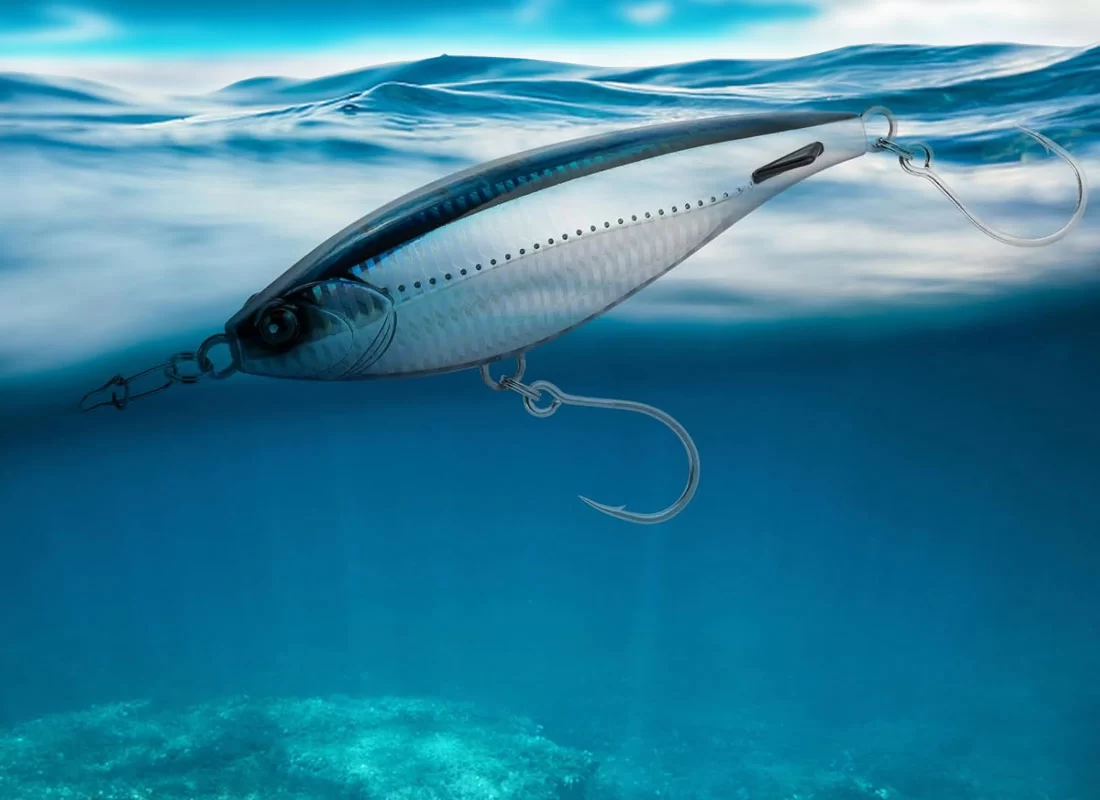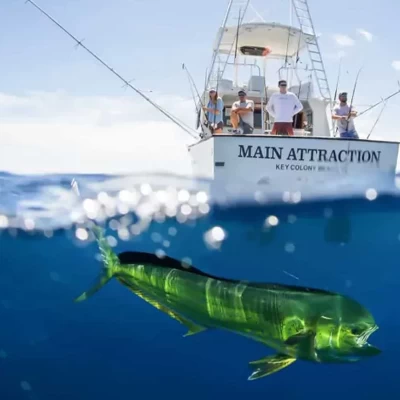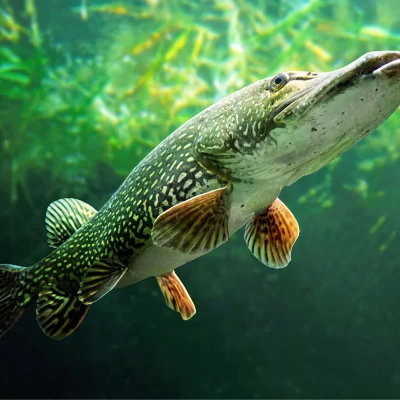Part 1: The Action
Mastering Lure Action: A Guide to Optimizing Fishing Performance
Fishing, at its core, is both an art and a science. And like any creative endeavor, the right tools play a pivotal role in bridging skill with success. In the world of angling, fishing lures stand as the centerpiece of this relationship. While their appearance may catch your eye, it’s their subtle engineering—crafted for precision and performance—that truly captivates fish. If you’ve ever wondered what defines an effective lure action, this guide unpacks five key factors that can make or break your fishing experience.
1. Bib Design: The Engine Behind Action
Think of the bib on a lure as its driving force. The shape, size, and angle of the bib—or what some call the “mouth shape”—determine how your lure swims. At the same time, the position of the tow-point (where the fishing line attaches) plays a significant role in influencing its trajectory.
Still, it’s not just about the bib alone. Factors like hydrodynamics, engineering precision, and material flexibility also work behind the scenes, ensuring that the lure delivers a lifelike or enticing movement underwater. When these elements align perfectly, it’s magic—the kind that gets fish hooked.
2. Body Shape and Buoyancy: Balancing Forces to Perfection
The body shape of a lure influences its swimming style in profound ways. Curved-bodied classics like the Boomerang are renowned for their wider oscillations, while straight-bodied “minnow-style” lures tend to have tighter, more streamlined motions.
Buoyancy also serves as a game-changer. Floating lures typically exhibit livelier movements since their natural buoyancy resists the downward pull created by the bib. This delicate interplay between diving forces and buoyancy underscores an essential principle: a lure must strike a harmonic balance where opposing forces counteract each other without one dominating. Lures that succeed in maintaining this equilibrium are a joy both to fish with—and to watch in action.
3. Hardware: The Unsung Hero of Precision
The performance and action of a fishing lure can change dramatically based on its hardware—the hooks, split rings, and snap swivels attached to it. While small details, they directly affect weight distribution and balance. Lures are often designed to work with specific hardware configurations; even slightly oversized components can compromise their action or render them ineffective entirely.
Choosing the right hooks is critical here—not only for ensuring proper exposure but also for maintaining proportionality with the lure’s size. With every tweak you make to your rigging setup, always ask yourself whether you’re supporting or hindering the lure’s natural motion.
4. Speed: More Than Just Cranking the Reel
One of the simplest yet most misunderstood aspects of enhancing lure action is speed. As retrieval speed increases, hard-bodied lures begin to vibrate more intensely—a direct feedback loop between motion and resistance in water. However, there is a threshold. Push beyond it, and your lure may swim erratically or even “blow out,” breaking through the water surface in an uncontrolled roll.
Lures with bibs controlling their dive are often better suited for higher speeds compared to those pulled from their nose, but faster isn’t always better. Many lures shine brightest at slower speeds—a nuance particularly prized by anglers in Türkiye, who emphasize how crucial it is for a lure to engage immediately at low speeds. This is especially useful when casting into dense underwater vegetation or tight strike zones where every meter counts.
Pro tip: Experimentation with speed can help you discover your lure’s sweet spot—but start slow and steady before cranking things up!
5. Line Class: Letting Your Lure Breathe Through Water
Even the best-designed lure can struggle if paired with an unsuitable line class. Heavier fishing lines generate more drag, limiting a lure’s freedom to move naturally as it oscillates through water. This issue becomes especially apparent with smaller lures that lack the kinetic power to overcome such resistance effectively.
Here’s a relatable analogy to consider: imagine trying to create waves using a thin rope—it feels intuitive, smooth, effortless. Now switch to a thick mooring rope designed for securing ships; shaking it becomes significantly harder and less fluid. Similarly, a lightweight lure won’t perform well with an overly heavy fishing line—it’ll seem stiff and unresponsive instead of lively and enticing. Always opt for a line class tailored to your lure’s size and action as a simple but essential part of your setup strategy.
Putting It All Together
At the heart of fishing success lies an understanding of these interwoven dynamics—bib design, body shape, hardware balance, retrieval speed, and line selection—all working in tandem to create irresistible action underwater.
Part 2: The Dept
The Art of Depth: Mastering Lure Tactics for Successful Fishing
Fishing is as much about strategy as it is about patience. One key factor that often determines success is understanding how to control the diving depth of your fishing lures. Whether you’re targeting midwater predators or bottom-dwellers, the depth at which your lure works its magic can make or break your day on the water. Let’s dive into the intricacies of lure depth and explore the factors that govern this crucial element of fishing.
1. Bib Design: The Game-Changer
The diving ability of a fishing lure is heavily influenced by the design of its bib (also known as the mouth shape). The shape, size, and the angle at which it attacks the water, coupled with the positioning of the tow point (eyelet or steel plate where the fishing line attaches), all work in harmony to determine how deep your lure will dive.
While these are primary factors, don’t overlook some secondary influences that might tip the scale when fine-tuning your setup.
2. Buoyancy: Floating or Sinking?
The buoyancy of your lure plays a pivotal role in its diving capabilities. For sinking lures, it’s simple—lower them to the desired depth, and that’s where they’ll stay. However, when dealing with floating lures featuring identical bib designs and sizes, the heavier one will generally plunge deeper.
Understanding how weight distribution impacts depth gives you a tactical edge when selecting your gear.
3. Hardware Adjustments: Finding Balance
Increasing a crankbait’s diving depth is as simple as adding weight—swap out hooks for larger, heavier ones or upgrade to heftier terminal tackle like swivels or snaps. But beware of going overboard. Adding too much weight can disrupt the lure’s action, making it lifeless and far less appealing to fish. Striking just the right balance between weight and motion is key.
4. Speed: Revving Up for Depth
Speed is another variable to keep in mind. A faster retrieve or an increase in trolling speed can send many lures deeper into the water column—up to a point. Push things too fast, though, and your lure may lose its stability, rising to the surface and “blowing out.” Moderation is your friend here.
5. Line Diameter: Slimming Down for Success
Don’t underestimate the impact of line thickness on your lure’s performance. A thinner line creates less resistance in the water, allowing your lure to dive deeper and perform as intended. Conversely, using a line that’s too thick or choosing an ill-matched fishing leader can sabotage your efforts.
In recent years, fine-diameter gel-spun lines have become a favorite among anglers. Not only do they facilitate deeper dives, but their low-stretch nature also enhances sensitivity—letting you feel every pulse of your lure’s action as it cuts through the water.
6. Line Length: The Misconception Unveiled
At first glance, it’s easy to assume that letting out more line automatically means deeper dives for your lure. While this holds true up to a certain extent, water resistance can quickly overturn this assumption. As you let out more line, drag forces from the moving water start working against you.
Here’s where things get interesting.
Picture this: You’re in a boat over a 50-meter-deep section of water with a sinking lure tied on. Drop it straight down, and it obediently hits bottom. Now start trolling forward. Instead of maintaining its depth, the lure begins to rise as water resistance pulls the line at an upward angle behind the boat. This happens regardless of whether there’s just a lure attached or even a heavy sinker—the horizontal movement generates lift due to drag.
When the upward force from water resistance matches the downward pull caused by the lure’s dive mechanics, it settles at an equilibrium depth. Say this occurs at 3 meters below the surface when your lure is 100 meters behind the boat. Adding another 100 meters of line won’t significantly push it lower—it primarily moves farther away from the boat without venturing any deeper.
This illustrates diminishing returns: extending more line achieves only marginal changes after a certain point. However, positioning your lure farther from the boat can be advantageous when you’re trying to reduce its interaction with surface noise—sometimes quiet presentation trumps depth anyway!
Bonus Insight: Observing Diminishing Returns with Shorter Lines
Interestingly, shorter line lengths can also offer insight into diminishing returns. If your lure runs at 3 meters deep with 20 meters of line out behind the boat, reeling it in to just 15 meters may bring it up slightly to 2.5 meters deep. This nuance is crucial knowledge for anglers fine-tuning their presentations.
Troubleshooting Guide: Quick Fixes for Common Lure Issues
| Problem | Likely Causes | Solutions |
|---|---|---|
| Lure won’t dive | – Line too thick – Bib angle too flat | Switch to thinner line (e.g., 8–12 lb fluorocarbon) Use a steeper-bibbed lure |
| Erratic action | – Oversized hooks/swivels – Speed too high | Downsize hardware Slow retrieve speed |
| Lure rises unexpectedly | – Buoyancy too high – Line too short | Add weight (e.g., heavier hooks) Let out more line or troll slower |
| No strikes despite action | – Depth mismatched to species – Action too rigid | Adjust diving depth (see species tips below) Swap to a more flexible lure |
| Lure “blows out” (surfaces) | – Speed too fast – Bib design flaw | Slow retrieval Test a lure with a larger bib or sturdier construction |
Species-Specific Tips for Turkish Waters: Action & Depth Strategies
1. European Seabass (Dicentrarchus labrax)
- Preferred Depth: 1–5 meters (weeds, submerged trees, dam lakes)
- Action: Aggressive wobble with sudden pauses (mimics injured baitfish).
- Lure Examples: Shallow-diving crankbaits, soft plastic jerkbaits.
- Pro Tip:
- In murky waters (e.g., Büyük Menderes River), use loud rattling lures.
- In clear lakes (e.g., Köyceğiz Lake), opt for natural-colored lures with slow retrieves.
2. Northern Pike (Esox lucius)
- Preferred Depth: 1–3 meters (reed edges, drop-offs)
- Action: Flashy, erratic jerks (triggers ambush strikes).
- Lure Examples: Large spinnerbaits, red-accented jerkbaits.
- Pro Tip:
- Use steel leaders – pike easily slice through nylon lines with their sharp teeth!
- Target reed zones at dawn/dusk in lakes like Sapanca.
3. Brown Trout (Salmo trutta)
- Preferred Depth: 0.5–2 meters (river currents, shallow shelves)
- Action: Subtle shimmy with occasional twitches (mimics insects/small fish).
- Lure Examples: Mini crankbaits, inline spinners.
- Pro Tip:
- In fast-flowing rivers (e.g., Çoruh River), use sinking lures.
- In calm lakes (e.g., Abant Lake), try suspending lures with pauses.
4. Zander (Sander lucioperca)
- Preferred Depth: 3–10 meters (deep rocky structures, sandy bottoms)
- Action: Slow, steady vibrations (matches their energy-efficient hunting style).
- Lure Examples: Deep-diving crankbaits, jigs with soft plastics.
- Pro Tip:
- Fish at dawn/dusk in reservoirs like Atatürk Dam Lake.
- Avoid bright midday light – zander retreat to deeper zones.
5. Gilt-head Seabream (Sparus aurata)
- Preferred Depth: 1–4 meters (coastal rocks, lagoons)
- Action: Twitch-pause retrieves (mimics fleeing juvenile fish).
- Lure Examples: Topwater poppers, UV-enhanced soft plastics.
- Pro Tip:
- In turbid Aegean/Mediterranean waters, use fluorescent-colored lures.
- Target shallow bays (e.g., Güllük Gulf) during tide changes.
6. Bluefish (Pomatomus saltatrix)
- Preferred Depth: 0.5–3 meters (open-water schooling zones)
- Action: Fast, aggressive retrieves (mimics sardine schools).
- Lure Examples: Metal jigs, large stickbaits.
- Pro Tip:
- Fish surface waters in the Istanbul Strait during autumn migration.
- Use silver-colored lures for early morning bites.
Turkey-Specific Fishing Insights
- Freshwater Tactics: In dam lakes (e.g., Keban, Hirfanlı), focus on artificial reefs and submerged trees.
- Saltwater Tactics: Near Mediterranean coral reefs, use slow-jigging for bottom species like dusky grouper.
- Lure Colors: Match local baitfish (e.g., anchovy, sand smelt) with silver/white or green-backed patterns.
Conclusion: Depth Is All About Balance
Mastering the interplay between lure action and diving depth is the hallmark of a skilled angler. Whether optimizing a lure’s tantalizing wiggle or fine-tuning its plunge into the strike zone, success hinges on balancing five core elements: bib design, buoyancy, hardware, speed, and line dynamics. Each factor works in concert to create lifelike movement and precise depth control—tools that transform a simple cast into a strategic pursuit.
For lure action, the bib acts as the engine, while body shape and buoyancy dictate rhythm. Hardware choices and line class refine responsiveness, and speed determines whether the lure dances or falters. In the realm of diving depth, buoyancy and weight distribution are king, but line diameter, retrieval tactics, and even physics (like drag and lift) demand equal attention.
Ultimately, fishing isn’t just about gear—it’s about adaptation. Experiment with configurations, observe how water resistance shifts outcomes, and learn when to prioritize stealth over depth. By embracing these principles, you’ll unlock lures that don’t just mimic prey—they outwit predators.
FAQs: Lure Action & Diving Depth Demystified
1. What’s the most critical factor for a lure’s action?
The bib design is foundational. Its shape, angle, and tow-point positioning dictate movement. However, balance with body shape, buoyancy, and hardware is equally vital.
2. How does line thickness affect diving depth?
Thinner lines reduce water resistance, allowing lures to dive deeper. Heavy lines create drag, limiting depth potential. Gel-spun lines are ideal for maximizing sensitivity and dive performance.
3. Can adjusting my retrieval speed change a lure’s depth?
Yes! Faster retrieves can drive lures deeper—up to a point. Exceeding a lure’s speed tolerance causes instability (“blowouts”). Slower speeds often enhance action in dense cover or cold water.
4. Do heavier hooks improve diving depth?
They can, but with trade-offs. Heavier hardware adds weight for deeper dives but may dampen action. Always prioritize balance—oversized hooks can make lures sluggish.
5. Should I use floating or sinking lures for midwater fish?
Floating lures with weighted bibs excel at midwater action, as buoyancy resists the dive force. Sinking lures are better for precise depth control but require constant adjustment.
6. Does letting out more line always mean deeper dives?
Not indefinitely. Beyond a certain length, water resistance creates upward lift, limiting depth gains. Focus on line type (thin) and speed over sheer length for optimal results.
7. What’s “diminishing returns” in line length?
It’s when adding more line yields minimal depth increases due to drag. For example, 100 meters of line might achieve 3 meters deep, but doubling the line only adds negligible depth.
8. How do I fix a lure that swims erratically?
Check for:
- Hardware imbalance (oversized hooks/swivels).
- Line mismatch (too thick for the lure’s size).
- Speed issues (slow down or adjust rhythm).








